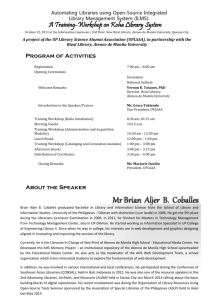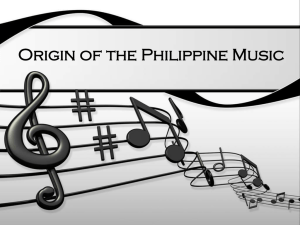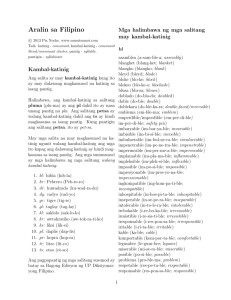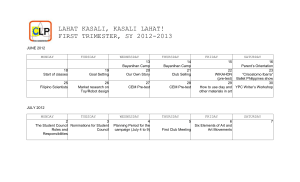- Kritika Kultura
advertisement
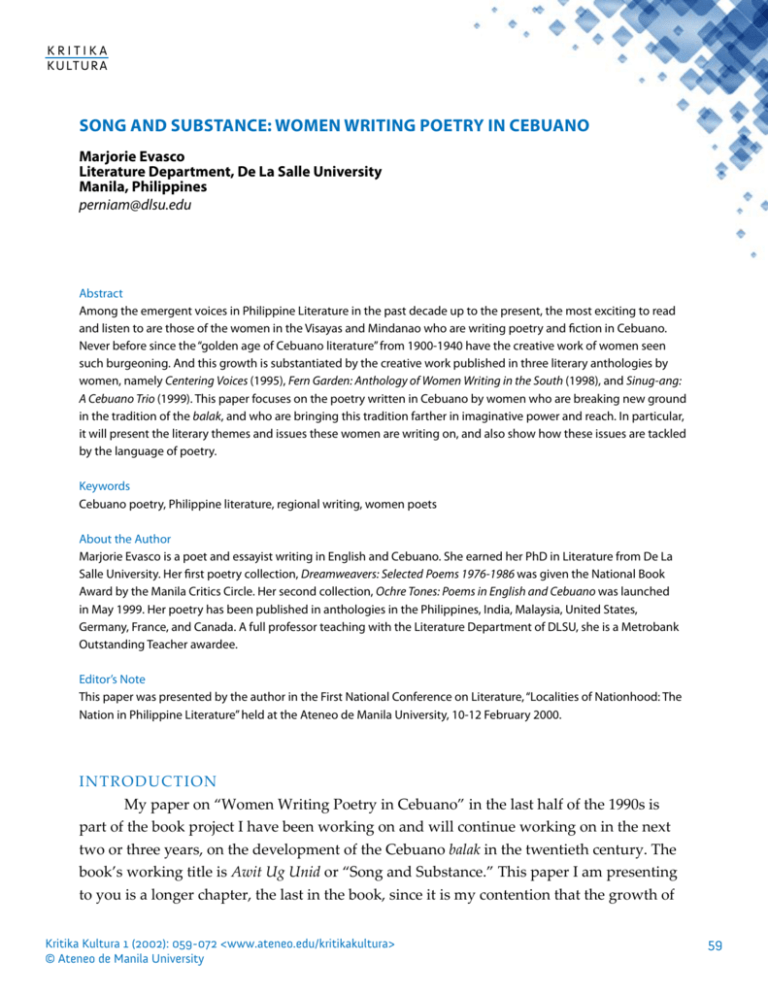
K r i t i ka Ku lt ur a SONG AND SUBSTANCE: WOMEN WRITING POETRY IN CEBUANo Marjorie Evasco Literature Department, De La Salle University Manila, Philippines perniam@dlsu.edu Abstract Among the emergent voices in Philippine Literature in the past decade up to the present, the most exciting to read and listen to are those of the women in the Visayas and Mindanao who are writing poetry and fiction in Cebuano. Never before since the “golden age of Cebuano literature” from 1900-1940 have the creative work of women seen such burgeoning. And this growth is substantiated by the creative work published in three literary anthologies by women, namely Centering Voices (1995), Fern Garden: Anthology of Women Writing in the South (1998), and Sinug-ang: A Cebuano Trio (1999). This paper focuses on the poetry written in Cebuano by women who are breaking new ground in the tradition of the balak, and who are bringing this tradition farther in imaginative power and reach. In particular, it will present the literary themes and issues these women are writing on, and also show how these issues are tackled by the language of poetry. Keywords Cebuano poetry, Philippine literature, regional writing, women poets About the Author Marjorie Evasco is a poet and essayist writing in English and Cebuano. She earned her PhD in Literature from De La Salle University. Her first poetry collection, Dreamweavers: Selected Poems 1976-1986 was given the National Book Award by the Manila Critics Circle. Her second collection, Ochre Tones: Poems in English and Cebuano was launched in May 1999. Her poetry has been published in anthologies in the Philippines, India, Malaysia, United States, Germany, France, and Canada. A full professor teaching with the Literature Department of DLSU, she is a Metrobank Outstanding Teacher awardee. Editor’s Note This paper was presented by the author in the First National Conference on Literature, “Localities of Nationhood: The Nation in Philippine Literature” held at the Ateneo de Manila University, 10-12 February 2000. Introduction My paper on “Women Writing Poetry in Cebuano” in the last half of the 1990s is part of the book project I have been working on and will continue working on in the next two or three years, on the development of the Cebuano balak in the twentieth century. The book’s working title is Awit Ug Unid or “Song and Substance.” This paper I am presenting to you is a longer chapter, the last in the book, since it is my contention that the growth of Kritika Kultura 1 (2002): 059-072 <www.ateneo.edu/kritikakultura> © Ateneo de Manila University 59 Evasco S o n g a nd S u b sta n c e the balak tradition in the twenty-first century may very well be led by women—a complete turnaround from the way it was in the 1900s up to the 1940s which had been called the “golden age” of Cebuano writing. In 1990, Cebuano Studies scholar and literary critic Resil Mojares problematized the notions of region and regional writing in his essay called “Imagining Regions” (2-6), which introduced Handurawan, an occasional anthology of prizewinning works by so called “regional” writers published by the Cultural Center of the Philippines. Mojares then proposed a postmodern critique of the connotations and implications of the terms region and regional writing: outlying, peripheral, folkloric, parochial, subordinate. The regional also evokes the notion of survivals, of something residual. This is so in a situation where the nation-state is assumed to be an achieved reality, where localities have been (or are imagined to be) effectively incorporated into a larger, supra-regional community. What harkens to the regional is then perceived to be nativistic, nostalgic, even (for believers in ‘official’ nationalism, whose failing is to let idea outstrip reality) divisive and subversive. (2) Arguing for a constantly “interacting mutually-constitutive” realities of region and nation in relation to the process of nation formation, Mojares advocated the idea that there is a need to challenge “our pallid constructs of the nation-state” and begin to open our eyes to what had been for so long marginalized: the richness and variety of living cultures and lifeways, memories and artifacts of the islands outlaying Manila and the National Capital Region (NCR). Mojares concludes: Indeed, to return to the regions today is not to dismember but to remember, in its essential sense of retracing and rejoining together, into one vital, pulsing body, members dormant and disaffected. It is so to sound and deepen that well of common being out of which a ‘national literature’ is given breath and shape. (4) The study of the literatures of the Philippines in our time cannot afford to disregard the dynamic forces that continue to shape and reshape, define and redefine the nation and the region. Since the nation itself is still caught up in the process of formation, then its literatures are part of these processes. What should matter then is that the regional members of the nation-state assert the place of imaginative writing from the regions, Kritika Kultura 1 (2002): 059-072 <www.ateneo.edu/kritikakultura> © Ateneo de Manila University 60 Evasco S o n g a nd S u b sta n c e instead of submitting to a kind of “nationalism [which] requires… that we set aside, forget, our identities as a clan, tribe, or ethnic group in order to forge the consciousness of being a nation” (Mojares 4). This paper will be discussing the literature written by women in Cebuano in the 1990s as a continuation of this argument for other voices, especially those long marginalized, to be heard. Among the emergent voices in Philippine Literature in the past decade up to the present, the most exciting to read and listen to are those of the women in the Visayas and Mindanao who are writing poetry and fiction in Cebuano. Never before since the “golden age of Cebuano literature” from 1900-1940 has the creative work of women seen such burgeoning. And this growth is substantiated by the creative work published in three literary anthologies by women, namely Centering Voices (1995), Fern Garden: Anthology Women Writing in the South (1998), and Sinug-ang: A Cebuano Trio (1999). This paper focuses on the poetry written in Cebuano by women who are breaking new ground in the tradition of the balak, and who are bringing this tradition farther in imaginative power and reach. In particular, it will present the literary themes and issues these women are writing on and also show how these issues are tackled by the language of poetry. Centering Voices The first of the anthologies to emerge from the Visayas was published in Cebu City in 1995 by the Women in Literary Arts, Inc. (WILA), with a funding grant from the National Commission on Culture and the Arts (NCCA). WILA was established in September 1991, and in four years it had grown from a handful of writers to more than twenty practitioners of the craft. Edited by Erlinda K. Alburo, Erma M. Cuizon and Ma. Paloma Sandiego, Centering Voices is composed of 21 contributors writing fiction and poetry in English and Cebuano. All the stories and poems in Cebuano are provided with English translations. Only seven of the 21 writers wrote in Cebuano. And of these, Ruby T. Enario (now Carlino), Jocelyn C. Pinzon, Catherine G. Viado, and Marvie Gil wrote in both English and Cebuano; while Erlinda Alburo, Leticia U. Suarez and Ester Tapia wrote only in Cebuano. What is important to note is that the latter three women otherwise write in English in workrelated writing in the academe, in media, and in the NGO sector. Therefore, it can be said that for Alburo, Suarez, and Tapia, Cebuano is the language of choice for their poetry. We will thus focus on the poetry by these three women in this anthology. Kritika Kultura 1 (2002): 059-072 <www.ateneo.edu/kritikakultura> © Ateneo de Manila University 61 Evasco S o n g a nd S u b sta n c e Erlinda Alburo Erlinda Alburo’s three poems in Cebuano are characterized by their strong narrative strategy, which hews close to the tradition of the Cebuano balak. The first poem, which is also the first poem in the anthology, takes to task the so-called “ideal” of Filipino womanhood—Maria Clara. The poem “Patay na Tuod si Maria Clara” [“Maria Clara is indeed, dead”] deconstructs the traditional notion of the sulondon [obedient], manggiulawon [shy], hinayon, [soft and serene] Filipino woman, and concludes with a dare operating on reverse psychology: “Si kinsa lay gustong santoson kay atong paantuson [Whoever still wants to be a saint, we will let her suffer.]” The poem’s conclusion is a manifesto for liberation: “Ang kinahanglan sa babaye karon / maalam molalik sa awit nga iyang tukaron, / maabtik mangitag idalit nga sud-anon, / molihok bisag wala pay bendisyon [What a woman needs now / is to know how to compose the song she will play, / be quick in finding the food she’ll give, / move even without blessing].” Alburo’s poem ends with the speaker asking: “Kon naa pa ron si Mama unsa kahay iyang ikasulti? [If Mother were still around, what would she have said?]” The discourse concludes with an ambiguous idiomatic expression mirisi, which can mean both “what a pity” and “good for her.” The line goes, “Nga labaw pang na-anhing kaniya si Maria Clara, mirisi. [That Maria Clara is deader than her, good for her.]” The operation of the ambiguity heightens the double entendre in the tone of the poem which declares Maria Clara and the mother of the persona irrelevant to the project of female empowerment. The term also points to the double meaning of tuod which can function both as a noun, meaning “deadwood,” and as an adverb meaning “indeed.” Leticia U. Suarez Leticia U. Suarez’s poems are neo-romantic lyrics informed by the politics of ecological consciousness. The one entitled “Tibalas,” for example, is an elegy to a dead tibalas, a small brown-feathered bird. The bird is killed by a nameless unemployed college graduate. In one fell swoop, Suarez’ poem mourns the death and vulnerability of nature and brings to the fore of consciousnes the evil effects of idleness: “Ninglubog na ang mga mata sa tibalas / Nga giluthang sa gradwadong walay lingaw [The light in the eyes of the tibalas has set/ Shot down by the idle college graduate].” While the description of the graduate does not specify the villain as male, the evocation of walay lingaw or idleness as well as the pastime of shooting birds point to a male culprit. Suarez’s voice of female protest packs power in the poem “Tambag Kang Beriang Kritika Kultura 1 (2002): 059-072 <www.ateneo.edu/kritikakultura> © Ateneo de Manila University 62 Evasco S o n g a nd S u b sta n c e Pakyas sa Gugma ug Uban Pa” [“Advice to Berta, Unfortunate in Love, Etc.”]. The persona addresses Berta and proceeds to deconstruct the dominant male narrative of love, using the traditional feminine language of cooking as the language of anger and rebellion. The focus of the poem’s argument for Berta’s liberation from punitive male language—“Ang maidlot niyang mga pulong” [His sharp words]—is the act of transformation through fire: “Dayong ihapnig sa kolon ni Lola / Timplahi, ayuha / Pabukali, hulata / Pabugnawa, sala­a / ang unod lubka [Then arrange them in grandmother’s earthen pot / Mix in the condiments for taste, Boil / Well, wait for it / To cool, then strain / Pound the meat].” Like the poem on the tibalas, Suarez’s persona brings the transformative act out of the personal and domestic sphere into the larger world where the ultimate transformation can take place. The most scathing criticism of human carelessness in relation to nature is “Camia,” a poem which addresses the fragrant white flower that grows in marshes and swamps. The voice laments the fact that the marshes and swamps are dead and in their stead are garbage dumps. The last stanza of the poem dramatizes the ironic efforts of art to preserve beauty: “Ug ikaw nga dili orkidya, dili luy-a / Karon dili na bulak apan / Hulagway na lamang nga idayandayan / Sa landong nga bungbong ning pinuy-anan / O kaha amag na lamang ning nagkalayang panumduman. [And you who are not orchid, nor ginger / You are no more than / A picture to decorate / The dark wall of this dwelling place / Perhaps you are merely an ember of wilting memory].” Ester Tapia Boemer Ester Tapia’s highly imagistic poems are delivered in perfect pitch. “Ang Banga” [“The Water Jar”] evokes the age-old task of women to fetch water early every morning in their earthen pots for the use of the entire family. And yet while this task is part of the female burden, the female persona focuses on the poetry of the task: “gisapwang ko sa akong duha ka palad / ang hagawhaw / sa napukawang tubig / ang hinaganas sa ilang kahimungawong [I carry with my two hands / the murmur / of the roused water / the rustle of its awakening].” With this tone and eye, the persona comes to a lyric conclusion: “Pagkabug-at sa banga / subay sa ngilit sa pangpang / ang katam-is [How heavy the jar is / as I walk the cliff-edge/ of sweetness].” It is Tapia’s narrative poem “Ang Asawa sa Mangingisda” [“The Fisherman’s Wife”] which exposes the suffering of women caught in the traditional gender roles: “ang asawa sa mangingisda / nagtindog sa baybayon / mga tikod mikutkot sa balas / ang pagtuya sa balod / mao ang tanan alang kaniya / nga ganay sa kinabuhi / ug kamatayon [the wife of the fisherman / stands on the beach / her heels dig into the sand / the rising and falling of Kritika Kultura 1 (2002): 059-072 <www.ateneo.edu/kritikakultura> © Ateneo de Manila University 63 Evasco S o n g a nd S u b sta n c e the wave / the rhythm of all her life / and death].” Caught in this world, the wife-persona weeps, and the metaphors of kitchen work are aptly chosen from the domestic space assigned to her: “gipunit niya ang baskit / sa asin ug bugas / ug unya / mga luha nga lunlon ahos / ug sibuyas nangatagak [she picks up the basket/ of salt and rice/ and tears of pure garlic/ and onions fall].” Fern Garden: Anthology of Women Writing in the South Three years after Centering Voices, a second anthology was published, again funded by the Committee on Literature of the National Commission on Culture and the Arts. Edited by poet Merlie Alunan, the anthology had a wider coverage, this time including writers from all the islands of the Visayas and Mindanao. The anthology has works written in any of five languages: English, Cebuano, Waray, Hiligaynon, Kinaray-a. In her critical introduction, Alunan says: We intended a representation of the variety and diversity of women writers in the south. It includes such established writers as Edith L. Tiempo herself, Aida Rivera Ford…Elsa Victoria Coscolluela, and Erma Cuizon. Majority [sic] are writers still struggling to find their voices.… None of them are full-time writers. (Fern Garden 2) The poetry and fiction in the anthology are mostly culled from periodicals like Bisaya, Hiligaynon, Yuhom, and from the earlier anthology, Centering Voices. In the poetry section, there are 44 writers and of these, Erlinda Alburo, Merlie Alunan, Pafuncia Borja, Ruby Enario, Marvi Gil, Ester M. Jundis, Marianita Mangubat, Luz de Mañana, Jocelyn Pinzon, Fe Echavia Remotigue, Lucia Segaffa, Leticia U. Suarez, Ester Tapia, and Catherine Viado write only in Cebuano. Of four poems in the anthology, Alunan’s three poems in Cebuano speak of her very recent movement away from English—a strategic move which seems to be the way of the writers who first wrote in English and then wrote bi-lingually, either writing directly in Cebuano and English, or translating works in English into Cebuano. Alunan’s introduction clarifies this movement within the context of the problematic notions of “nation” and region”: Kritika Kultura 1 (2002): 059-072 <www.ateneo.edu/kritikakultura> © Ateneo de Manila University 64 Evasco S o n g a nd S u b sta n c e The south is a sociopolitical idea. It implies a dominant north where resources, talent, expertise are concentrated, where power and authority emanate, where quality of performance is assessed and affirmed. For the southern writer, the concept of the north includes a colonizing national language which reduces the regional languages to secondary status. Away from the center, southern lifeways thrive on their own. These lifeways yield their own stories, and breed their own unique modes of thinking and seeing. Crude though this may seem, the north-south configuration nevertheless forms a dimension of the composite national reality. The rhythms of southern speech are as diverse as the languages spoken in the major Visayan islands and among the many tribes of Mindanao. The diversity of language also implies a diversity of attitudes and habits of thinking. Most, if not all the women represented in this volume write in English. Those who write in their native tongue are aware of the politics of their choice, realizing it as an effort to restore or regain lost ground and to reassert them as medium for the works of the imagination. (Fern Garden 3, emphasis mine) Ruby Enario Carlino Ruby Enario-Carlino of Cebu City is one of the younger writers writing in English and Cebuano. Her one poem in Cebuano in this anthology tackles the story of Nana Salvacion, one of the “comfort women” during the war. The persona dedicates the poem to Nana Salvacion, aged 69. And it is a compassionate female voice that confronts with Nana Salvacion the trauma of the past and refuses to grant forgiveness to the ones who committed these war crimes against women: Kinsa may gustong mangutingkay sa nangagi? Aduna nay daghang apo sa tuhod ug sungkod, Bisan pa ug ilubong ug bulawan ug sapi Din na mapapas ang labod sa dughan ug likod, Ang hulagway sa mga dilang naglataylatay Sa alimpatakan, may daa pang talidhay ug laway. [Who wants to unearth the past? Many are the grandchildren and great grandchildren, And even if I would be buried in gold and money The living scars on my breasts and back cannot be erased, Kritika Kultura 1 (2002): 059-072 <www.ateneo.edu/kritikakultura> © Ateneo de Manila University 65 Evasco S o n g a nd S u b sta n c e The image of their tongues crawling all over In my brain, their mocking laughter, their spit.] Fe Echavia Remotigue While Ruby Enario-Carlino’s poem speaks of the female’s heroic gesture of remembering and refusing forgiveness, Fe Echavia Remotigue of Davao City shows women the way to transform oppression into liberation in her poem “Madyik” [“Magic”]. The strategy starts with liberation in language: “Gikandaduhan niya / ang baba ko / Pwerte nakong / katawa / kay ang yabe / ania sa akong kamot [He locked / my mouth / Loud / I laughed / for the key / is here in my hand].” The image of the key in the woman’s hand is the central metaphoric device which the persona uses to assert the transformation of key to pen to rifle. And its conclusion is a revolutionary one: “Pagkadaghan sa hitsura / sa nag­ isa’g kamot / aron ipatumba / ang monumento sa hari [The shapes of images are many, / as many as those whose hands are raised / to bring down / the monument of the king].” S i n u g -a n g : A C e b u a n a T r i o On their eighth anniversary in September 1999, WILA once again marked another year of spunk and gumption in the field of creative writing with a second anthology of poetry by three of its members: Erlinda Alburo, Ester Tapia, and Corazon Almerino. Printed in feminist lavender, the cover designed by Ma. Jessamyn K. Alburo, uses the motif of the triangle with three female figures doing the feminine tasks of fetching water in the earthen banga, rocking a baby to sleep, and playing the flute. And on the copyright page is a linguistic explanation of the title and cover: “Sinug-ang [fr. sug-ang, n. a triangularly placed stove tripod stand for cooking, wood burner composed of three stones triangularly arranged; also sug-angan, Dictionary of Cebuano Visayan by John Wolff, 1971].” The motif of the Sinug-ang becomes the central analogue of the book’s introduction, written in Cebuano by poet Merlie Alunan. This introduction is a welcome and refreshing gesture in itself because Alunan used to write poetry and critical essays only in English. She starts her critical introduction entitled “Paghimo og kalan nga sinug-ang ug uban pang panghunahuna bahin sa balak ug sa pagkababaye” [“How to build a three-sided stove and other thoughts on poetry and womanhood”] with sections on “Paghimo og kalan” [“How to build the stove”] and “Ang Pagpanimpla” [“Taste”]. Between these two concepts of food preparation, she re-creates the locus of the female and poetry, “Si Inday ug ang balak” Kritika Kultura 1 (2002): 059-072 <www.ateneo.edu/kritikakultura> © Ateneo de Manila University 66 Evasco S o n g a nd S u b sta n c e [“Inday and poetry”]. The critical project does not deconstruct the notion of the kitchen as a “woman’s place” and cooking as a “woman’s task.” Rather, it reclaims the territory with the assertion of practical and artistic wisdom, passed on from one generation of women to another: Timan-i nga bisan kalan lang, dunay gabayan sa husto nga pamarog. Ang mubong kalan angay ra kung magdangdang kag binuwad nukos o magsugbag isda. Mao nay gitudlo nako ni Nay Aming, ang akong inahan. Dunay eksaktong timplada para sa bisag unsang buhaton sa kinabuhi. (Alunan, Sinug-ang 1) [Remember that even if you are using only this earthen hearth, there are guides for its use in right relation to its height. The low stove is only good for grilling dried squid or broiling fish. This is what Mama Aming, my mother, taught me. There is a precise measure and flavor for everything one does in life.] It is in the discussion of the art of getting the right taste where the introduction articulates from a new ironic viewpoint the old bias against women who enter and inhabit the world of writing: Anad na ang atong dalunggan sa gahob sa inga sa mga Ondo inig-uli nila makaadlawon nga hubog og pakyas sa gugma. Kasagaran ra ni kaayo. Apan ang mga Inday nga mag-apil—apil sad og inga ug pamudyong, murag mabag-ohan gyud tang maminaw. Di ba na hilas? (3) [Our ears are so used to the groans of the male poets when they return at dawn drunk and failed in love. This is much too common. But of the women who join in the groaning of poetry, we are shocked to listen to them. Isn’t their audacity embarrassing?] Having posed the question, Alunan sets the ground for her critical position regarding female writing and the tradition of Cebuano poetry. She calls the anthology a rare event, talagsaon ang maong hitabo. Like a host in a fiesta, she invites us to savor the fare prepared for us by poet-chefs Alburo, Tapia and Almerino. The anthology is conceptually divided into themes, with each poet contributing a poem or two to shed light on the poetic problem. It starts with the concept of SelfIdentity, Pag-ila sa kaugalingon, and ends with the experience of having a holiday, Bakasyon. Kritika Kultura 1 (2002): 059-072 <www.ateneo.edu/kritikakultura> © Ateneo de Manila University 67 Evasco S o n g a nd S u b sta n c e But between these two markers, the three poets wrestle with the weight of traditional notions, now problematized and seen with new eyes: the relationship among women, the relationship with men, youth, marriage, motherhood, parting, the darkness of the soul, awakening, friendship, nature, language, etc. The most successful among the poems are those which yoke substance and form into an awakened sense of language and its power. Erlinda Alburo Linda Alburo’s “Babayeng Nag-atubang sa Salamin” [“Woman facing the mirror”] is a powerful concrete poem whose visual form is an analogue for the female body’s shape, but whose mature and wise articulation departs from the usual narcissistic projection into a new awareness of the slippery nature of words and meanings themselves: “nag-atubang ko karon / sa usa sab ka salamin / kahibalo na ko / nganong nabali / ang tanan / nganong dili / matusok / ang naglawig /nga kahulogan [I now face / another mirror / I now know / why everything / turns inside out / why I cannot / pierce through / meanings / which are at sea].” Cora Almerino The playful and young imagination of Cora Almerino offers us the humor and pathos of female desire. While the focus of attention is still the ubiquitous male, the ironic attitude of the poems opens up spaces of delightful laughter, which is always self-reflexive, and thus potentially liberating. In the section “lbid-ibid” [“Flirtation”], the poem “Tubigtubig” [“Game of water tag”] dramatizes the play of desire: the female speaker is out to catch the beloved in a child’s game whose boundaries are marked with water. She is skilled at the game but her aims are thwarted by the beloved’s counter-strategies: Ang nakaapan lang, hanas kaayo kang molipat-lipat. Sutoy kang modagan mao nga gahangos ko. Nahumod sa singot. Namuypoy na ang akong mga bukton. Ang akong baba kalit ningtak-om. Daw mahugno ang akong pagsagang Onianang imong paghata-hata padulong ning dughan. Kritika Kultura 1 (2002): 059-072 <www.ateneo.edu/kritikakultura> © Ateneo de Manila University 68 Evasco S o n g a nd S u b sta n c e [Trouble is, you are skilled in deception. Fleetfooted you run and I pant. I am soaked with sweat. My arms are weary. My mouth is suddenly clamped shut. It is as if my defenses are defeated by your false attempts to cross the line into my heart.] Ester Tapia Ester Tapia’s poetry, on the other hand, delivers their power through its tone and perfect pitch. In poem after liquid poem of surreal beauty, poetic realization breaks through with the wedge of language into a new space where the imagination asserts its freedom and affirms its capacity to shape new meanings. In the poem “Mason” [“Stonebuilder”], Tapia’s speaker recognizes the intent of male desire and refuses complicity: Mason nga mitutok kanako gikan sa pikas nga daplin niining lawa diin akong gituslob ang akong tiil sa tubig dili ko maghumod dili ko maligo niining tubig nga puno sa panghupaw sa iyang mga abaga mitihol ang mga abog ang iyang maong gision sa tuhod ang hugong sa umaabot nga mga palasyo misaka gikan sa kakahoyan ang mga bato mipundok sa ilang kaugalingon misakmit sa tinagoan sa kadahonan ug dili ko manginlabot niya Kritika Kultura 1 (2002): 059-072 <www.ateneo.edu/kritikakultura> © Ateneo de Manila University 69 Evasco S o n g a nd S u b sta n c e mason sa lahing kahusay bisan kon ang samin niining malumo nga lawa naukay sa iyang mga mata [Stonebuilder staring at me from the other shore of this lake where I dip my feet in the water I will not get wet nor bathe in this water filled with sighs from his shoulders the dust whistles and from his jeans torn at the knees the roar of future palaces rises from the trees the stones gather unto themselves snatching the secret of the leaves and I shall have none of him stonebuilder of a different order even though the mirror of this languid lake has been stirred by his eyes] What is perhaps most telling of the theme of freedom in the anthology are the poems on taking a holiday. Ester Tapia’s poem re-enters the mangrove at a river’s mouth where the speaker remembers having picked up with Ranie: “tiyan sa kaha, / ug mga kinhason nga gihulmahan / ug sa dahon nga pikas/ nga pako sa usa ka anghel // ato kini silang gibakwi / balik ngadto sa lilo / sa katahom ug kasakit / kining mga biniyaang bukog / arong atong kaawitan [belly of the frying pan, and the seashells used as moulds / and the unpaired leaves / the wings of an angel // we will reclaim them / back into the whirlpool / of beauty and sorrow / these abandoned bones / for which we sing].” Kritika Kultura 1 (2002): 059-072 <www.ateneo.edu/kritikakultura> © Ateneo de Manila University 70 Evasco S o n g a nd S u b sta n c e In the final analysis, the mind and heart’s tongue that savors the lifelong feast offered by Sinug-ang is inevitably changed and revivified by the new flavors of things that truly nourish the imagination. And life is never the same again because one has been taught how to sing even to the abandoned bones of daily living. Conclusion At the threshold of the 21st century, female writers from the Visayas and Mindanao are actively claiming language to assert the power of their new ways of seeing and saying things. These three anthologies show us what they can do and where they can go. It will not be farfetched to predict that in the next century many of them will be publishing their individual collections of poetry in Cebuano, the dominant language of the southern part of the Philippines. And never again will they be silenced by any of the groups who arrogate unto themselves the power of literature. Kritika Kultura 1 (2002): 059-072 <www.ateneo.edu/kritikakultura> © Ateneo de Manila University 71 Evasco S o n g a nd S u b sta n c e WORKs Cited Alunan, Merlie. Introduction. Fern Garden: Anthology of Women Writing in the South. Ed. Merlie Alunan. Manila: Committee on Literature, National Commission on Culture and the Arts, 1998. 2-3. ---. “Paghimo og kalan nga sinug-ang ug uban pang panghunahuna bahin sa balak ug sa pagkababaye.” Introduction. Sinug-ang: A Cebuana Trio. Eds. Ester Tapia, Linda Alburo, Cora Almerino. Cebu City: Women in Literary Arts, 1999. Mojares, Resil B. “Imagining Regions.” Introduction. Handurawan. Manila: Cultural Center of the Philippines, 1988. 2-6. Wolff, John U. A Dictionary of Cebuano Visayan. Manila: Linguisitic Society of the Philippines, 1971. Kritika Kultura 1 (2002): 059-072 <www.ateneo.edu/kritikakultura> © Ateneo de Manila University 72
